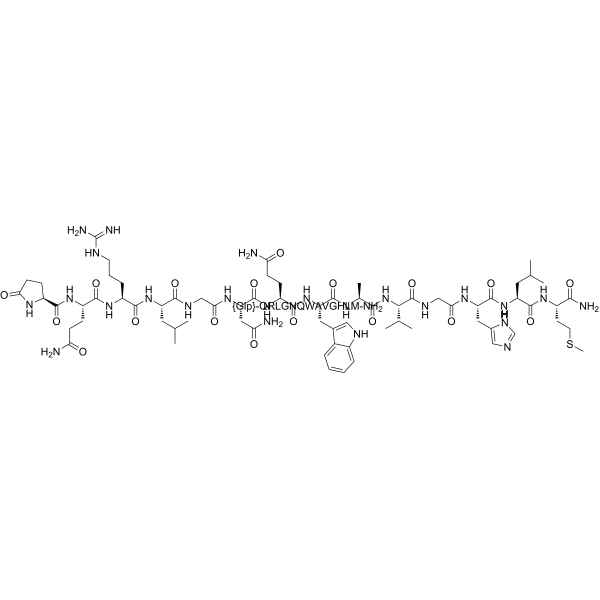Bombesin Receptor
The family of G protein-coupled mammalian bombesin receptors comprises the gastrin-releasing peptide receptor (GRP-R or BB2-receptor), the neuromedin B receptor (NMB-R or BB1-receptor) and the orphan bombesin receptor subtype-3 (BRS-3 or BB3-receptor). These of G protein-coupled receptors mediate biological effects of bombesin related peptides (BLP). The amphibian regulatory peptide bombesin and its mammalian homologue GRP bind with high affinity to the GRP-R, whereas NMB selectively binds to the NMB preferring receptor NMB-R. No native ligand has been identified for the orphan BRS-3. Both regulatory BLPs, GRP and NMB, are processed from larger precursor molecules and are found widely distributed in the central nervous system (CNS) and in various peripheral tissues, such as neuronal elements of the gastrointestinal submucosal and myenteric plexus. Their biological effects include a broad range of important physiological and pathophysiological functions in health and disease.
GRP and NMB both exert effects on cell growth and differentiation in various epithelial cell derived tumors. In addition, GRP stimulates secretion from the pancreas, release of gastrointestinal hormones, smooth muscle contraction and affects immune cells. Furthermore, GRP affects the CNS, including regulation of the circadian rhythm, anxiety and fear responses as well as thermoregulation; owing to its expression in the spinal cord, GRP has been recently also associated with the chronic itch sensation and penile reflexes. Tumors of the lung, prostate, head and neck, CNS, pancreas and colon have been shown to exhibit mitogenic response to GRP and NMB, whereby agonist signals generally activate the Raf-MEK-ERK mitogen-activated protein kinase cascade. In colorectal cancer cells, it was demonstrated that GRP activated focal adhesion kinase (FAK) and upregulated intracellular adhesion molecule (ICAM)-1 expression thereby promoting cell motility and attachment to the extracellular matrix. In neuroblastoma cells, bombesin induced the expression of angiogenic markers, including platelet/endothelial cell adhesion molecule (PECAM)-1, vascular endothelial growth factor (VEGF) and elevated p-AKT levels, whereas GRP or GRP-R silencing significantly inhibited these changes.In prostate cancer cells, bombesin can mediate androgen receptor activity in a Src-dependent manner and possibly also involve nonreceptor tyrosine kinases focal adhesion kinase (FAK) and Etk/Bmx.
References
1.Weber HC,et al. Curr Opin Endocrinol Diabetes Obes. 2009 Feb;16(1):66-71.
GRP and NMB both exert effects on cell growth and differentiation in various epithelial cell derived tumors. In addition, GRP stimulates secretion from the pancreas, release of gastrointestinal hormones, smooth muscle contraction and affects immune cells. Furthermore, GRP affects the CNS, including regulation of the circadian rhythm, anxiety and fear responses as well as thermoregulation; owing to its expression in the spinal cord, GRP has been recently also associated with the chronic itch sensation and penile reflexes. Tumors of the lung, prostate, head and neck, CNS, pancreas and colon have been shown to exhibit mitogenic response to GRP and NMB, whereby agonist signals generally activate the Raf-MEK-ERK mitogen-activated protein kinase cascade. In colorectal cancer cells, it was demonstrated that GRP activated focal adhesion kinase (FAK) and upregulated intracellular adhesion molecule (ICAM)-1 expression thereby promoting cell motility and attachment to the extracellular matrix. In neuroblastoma cells, bombesin induced the expression of angiogenic markers, including platelet/endothelial cell adhesion molecule (PECAM)-1, vascular endothelial growth factor (VEGF) and elevated p-AKT levels, whereas GRP or GRP-R silencing significantly inhibited these changes.In prostate cancer cells, bombesin can mediate androgen receptor activity in a Src-dependent manner and possibly also involve nonreceptor tyrosine kinases focal adhesion kinase (FAK) and Etk/Bmx.
References
1.Weber HC,et al. Curr Opin Endocrinol Diabetes Obes. 2009 Feb;16(1):66-71.
GPCR/G Protein
ACAT(3)
Angiotensin Receptor(27)
Antibacterial(545)
Bombesin Receptor(13)
Bradykinin Receptor(23)
Calcium Channel(197)
cAMP(16)
Cannabinoid Receptor(88)
CaSR(18)
CGRP Receptor(18)
Chemokine Receptor(104)
Cholecystokinin Receptor(24)
CRF Receptor(15)
Dopamine Receptor(182)
Endothelin Receptor(28)
FFAR(5)
Galanin Receptor(1)
GHSR(20)
Glucagon Receptor(51)
GPCR19(9)
GPR119(3)
Hedgehog (Hh)(35)
Histamine Receptor(139)
Imidazoline Receptor(1)
Leukotriene Receptor(15)
LHR(1)
LPA Receptor(19)
Lysophospholipid Receptor(13)
mAChR(25)
MCHR(8)
Melanocortin Receptor(28)
Melatonin Receptor(7)
Motilin Receptor(4)
Neurokinin Receptor(43)
Neuropeptide Y Receptor(44)
Neurotensin Receptor(11)
Orexin Receptor(16)
Other Targets(3)
OXTR(2)
P2Y Receptor(14)
PAR(28)
Platelet-activating Factor Receptor(2)
Prostaglandin Receptor(79)
PTH Receptor(1)
S1P Receptor(35)
SGLT(26)
Somatostatin Receptor(16)
Urotensin Receptor(4)
Vasopressin Receptor(20)
Bombesin Receptor
-
PD 168368
产品货号 : M37589
cas no: 204066-82-0
PD 168368 是一种有效的、竞争性的选择性神经调节蛋白 B 受体 (NMB-R) 拮抗剂,Ki 为 15-45 nM。 PD 168368 是神经调节素 B 受体(NMBR; IC50=96 nM)和胃泌素释放肽受体 (GRPR; IC50=3500 nM))的双重拮抗剂。PD 168368 还是一种 FPR1/FPR2/FPR3 的混合激动剂,EC50 分别为 0.57、0.24 和 2.7 nM。
-
PD176252
产品货号 : M33456
cas no: 204067-01-6
PD176252 是一种有效的 BB1 和 BB2 拮抗剂,能够抑制人 BB1 和 BB2 受体和大鼠 BB1 和 BB2 受体活性,Ki 值分别为 0.17 nM,1 nM 和 0.66 nM,16 nM;PD176252 同时为 FPR1/FPR2 的激动剂,在 HL-60 细胞中,EC50 值分别为 0.31 和 0.66 μM。
-
[D-Phe12,Leu14]-Bombesin
产品货号 : M30742
cas no: 108437-88-3
Bombesin receptor antagonist that inhibits bombesin binding to rat brain with an IC50 value of 2 μM. Inhibits amylase release in vitro (IC50 = 4 μM) and attenuates bombesin-mediated suppression of food intake in vivo.
-
BA 1
产品货号 : M30733
cas no: 183241-31-8
Potent bombesin receptor agonist (IC50 values are 0.26, 1.55 and 2.52 nM for BB1, BB2 and BB3 respectively). Enhances glucose transport in obese and diabetic primary myocytes. Also stimulates NCI-H1299 lung cancer cell proliferation in vitro.
-
Bombesin
产品货号 : M29980
cas no: 31362-50-2
Bombesin is a 14-amino acid peptide originally isolated from the skin of the European fire-bellied toad (Bombina bombina). It has two known homologs in mammals called neuromedin B and gastrin-releasing peptide.



 021-51111890
021-51111890 购物车(0)
购物车(0)
 sales@molnova.cn
sales@molnova.cn






